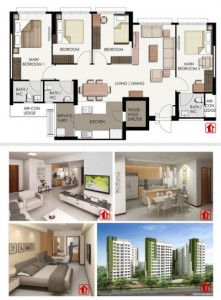Share This
Related Posts
Tags
MultiGen Multifamily
By Erica Rascón on Sep 8, 2014 in News
Pew Research reports that there are now more than 57 million Americans living in multi-generational homes. Traditional single-family products no longer meet the needs of today’s cross-generational households, paving the way for multigen, multifamily communities that offer flexible alternatives.
The uptick in multigen housing began in the 80s, inching from 12.1 percent of households to 18.1 percent in 2012. The top ten cities to experience the greatest growth include:
- El Paso, TX
- Madison, WI
- Cincinnati, OH
- Columbia, SC
- Little Rock, AR
- Ogden, UT
- Boston, MA
- Sacramento, CA
- Honolulu, HI
- Jacksonville, FL
In the traditional approach to multigen housing, parents move into renovated spaces or detached cottages on their adult children’s property. This isn’t a feasible option for every family because some existing homes don’t have the space or families don’t have the funds to make structural changes.
In 2012, single-family developers began marketing multi-generational products that don’t require costly renovations or add-ons. Lennar took the lead with NextGen, a model with two master suites and private entries, essentially providing two homes under one roof. Ryland Homes also offers a comparable multigen product, customizing properties to include separate kitchens.
that don’t require costly renovations or add-ons. Lennar took the lead with NextGen, a model with two master suites and private entries, essentially providing two homes under one roof. Ryland Homes also offers a comparable multigen product, customizing properties to include separate kitchens.
While these houses furnished a new way for families to unite, they create additional problems. Primarily, such single-family arrangements don’t address the significant number of seniors who do not want to impose on their children, or whose children can’t afford new construction or add-ons while still recuperating from the recession.
AgingCare depicts the struggle between seniors’ desire for independence and feasible housing scenarios. 46 percent of seniors believe children have a responsibility to provide financial support to their parents or in-laws, allowing a parent to live with them if he or she is unable to thrive alone. Oddly, many parents say they would not accept financial assistance from their children. In a similar survey by Gallup & Robinson, only 31 percent of those surveyed said they would live with a younger family member when they could no longer live on their own. In short, seniors want their children to offer support but many parents don’t want to become dependent.
Financial strain is a major deterrent. Certified financial planner Kevin Young has seen a growing number of working adults struggling to make ends meet. He tells US News, “They’re taking care of aging parents and children at the same time, sometimes working multiple jobs to accomplish that.” The “sandwich generation” is having difficultly saving for their retirement and their children’s education. Seniors are aware of these tensions and don’t want to be a burden.
Secondly, most new single-family communities are developed in the suburbs, far from public transit, work hubs, and other amenities that are priorities to seniors; within a half mile distance from home, seniors would like to have a doctor’s office, grocery store, hospital, place of worship and drug store according to an AARP study.
Multifamily construction addresses many seniors’ concerns at once. Apartment communities are better suited for infill projects, placing seniors closer to the pedestrian-friendly amenities that they desire. Mixed-income apartments offer budget-friendly options for seniors and their adult children. The community layout facilitates living within walking distance of loved ones while maintaining a degree of autonomy for both parties.

The layout of a multi-generational apartment in Singapore.
Avalon West Hollywood, for example, is a mixed-income community that will consist of two LEED Silver market rate complexes and a LEED Gold senior building. It allows younger adults to live in close proximity to their aging parents while maintaining independence and privacy. Particularly important to seniors, Avalon West Hollywood’s location near public transportation provides easy access to shopping, recreation, and health care facilities.
Affordable housing is also exploring cross-generational projects like Courier Place in Irvine. Courier Place caters to working families and seniors, located near public transit and major employment centers. LEED Platinum certification encourages environmental and financial benefits to seniors with limited incomes and growing families.
Multifamily is also rolling out budget-friendly solutions for seniors who may need to live under the same roof as their adult children for health or financial reasons. In Singapore, The Housing and Development Board has created 400 pairs of customized 3Gen flats. The layout includes two equally spacious bedrooms and adjacent baths. The 3Gen model is most like the single-family approach in a cost conservative apartment setting. America has yet to adapt a format such as 3Gen, though such a project could feasibly enjoy success in any of the Top 10 cities.
Multifamily is embracing the challenges of cross-generational housing with new models that seem to meet the needs of Boomers and their aging parents. Since many of these communities are in their nascent stages, only time will tell if multifamily will become the future for multigen housing.
